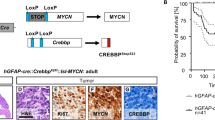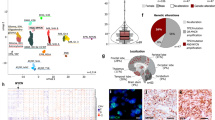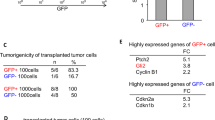Abstract
Mutations in receptor tyrosine kinase (RTK) growth factor receptors (epidermal growth factor receptor, platelet-derived growth factor receptor, MET and ERBB2), which result in downstream activation of the RAS/RAF/MEK/ERK mitogen-activated protein kinase (MAPK) pathway and PI(3)K/Akt pathway, are found in almost all high-grade gliomas and MAPK signaling is necessary for continued glioma maintenance. In addition, BRAF is mutated in the majority of low-grade gliomas and its expression and activity is significantly increased in the majority of high-grade gliomas. Although the importance of RTKs and RAS signaling in glioma development has been shown, the role of BRAF has yet to be characterized. We evaluated the effect of activated BRAF in glioma formation using the retroviral replication-competent avian leukosis virus long terminal repeat, splice acceptor (RCAS)/TVA system to transfer genes encoding activated forms of BRAF, KRas, Akt and Cre to nestin-expressing neural progenitor cells in Ink4a/Arflox/lox mice in vivo. Although expression of activated BRAF alone is not sufficient for tumorigenesis, the combination of activated BRAF and Akt or BRAF with Ink4a/Arf loss is transforming. Interestingly, activated BRAF generates gliomas with characteristics similar to activated KRas in the context of Akt but not Ink4a/Arf loss. Our studies show a role for BRAF activation and signaling in glioma development and as potential target for glioma therapy.
This is a preview of subscription content, access via your institution
Access options
Subscribe to this journal
Receive 50 print issues and online access
$259.00 per year
only $5.18 per issue
Buy this article
- Purchase on Springer Link
- Instant access to full article PDF
Prices may be subject to local taxes which are calculated during checkout






Similar content being viewed by others

References
Aguirre AJ, Bardeesy N, Sinha M, Lopez L, Tuveson DA, Horner J et al. (2003). Activated Kras and Ink4a/Arf deficiency cooperate to produce metastatic pancreatic ductal adenocarcinoma. Genes Dev 17: 3112–3126.
Balmanno K, Cook SJ . (2009). Tumour cell survival signalling by the ERK1/2 pathway. Cell Death Differ 16: 368–377.
Barnier JV, Papin C, Eychene A, Lecoq O, Calothy G . (1995). The mouse B-raf gene encodes multiple protein isoforms with tissue-specific expression. J Biol Chem 270: 23381–23389.
Basto D, Trovisco V, Lopes JM, Martins A, Pardal F, Soares P et al. (2005). Mutation analysis of B-RAF gene in human gliomas. Acta Neuropathol 109: 207–210.
Bromberg-White JL, Webb CP, Patacsil VS, Miranti CK, Williams BO, Holmen SL . (2004). Delivery of short hairpin RNA sequences by using a replication-competent avian retroviral vector. J Virol 78: 4914–4916.
Chin L, Pomerantz J, DePinho RA . (1998). The INK4a/ARF tumor suppressor: one gene—two products—two pathways. Trends Biochem Sci 23: 291–296.
Chong H, Lee J, Guan KL . (2001). Positive and negative regulation of Raf kinase activity and function by phosphorylation. EMBO J 20: 3716–3727.
Dahlstrand J, Collins VP, Lendahl U . (1992). Expression of the class VI intermediate filament nestin in human central nervous system tumors. Cancer Res 52: 5334–5341.
Dai C, Holland EC . (2003). Astrocyte differentiation states and glioma formation. Cancer J 9: 72–81.
Dai C, Lyustikman Y, Shih A, Hu X, Fuller GN, Rosenblum M et al. (2005). The characteristics of astrocytomas and oligodendrogliomas are caused by two distinct and interchangeable signaling formats. Neoplasia 7: 397–406.
Davies H, Bignell GR, Cox C, Stephens P, Edkins S, Clegg S et al. (2002). Mutations of the BRAF gene in human cancer. Nature 417: 949–954.
Furnari FB, Fenton T, Bachoo RM, Mukasa A, Stommel JM, Stegh A et al. (2007). Malignant astrocytic glioma: genetics, biology, and paths to treatment. Genes Dev 21: 2683–2710.
Guan KL, Figueroa C, Brtva TR, Zhu T, Taylor J, Barber TD et al. (2000). Negative regulation of the serine/threonine kinase B-Raf by Akt. J Biol Chem 275: 27354–27359.
Hamel W, Westphal M, Shepard HM . (1993). Loss in expression of the retinoblastoma gene product in human gliomas is associated with advanced disease. J Neurooncol 16: 159–165.
Hill JR, Kuriyama N, Kuriyama H, Israel MA . (1999). Molecular genetics of brain tumors. Arch Neurol 56: 439–441.
Hmitou I, Druillennec S, Valluet A, Peyssonnaux C, Eychene A . (2007). Differential regulation of B-raf isoforms by phosphorylation and autoinhibitory mechanisms. Mol Cell Biol 27: 31–43.
Holland EC, Celestino J, Dai C, Schaefer L, Sawaya RE, Fuller GN . (2000). Combined activation of Ras and Akt in neural progenitors induces glioblastoma formation in mice. Nat Genet 25: 55–57.
Holland EC, Hively WP, DePinho RA, Varmus HE . (1998a). A constitutively active epidermal growth factor receptor cooperates with disruption of G1 cell-cycle arrest pathways to induce glioma-like lesions in mice. Genes Dev 12: 3675–3685.
Holland EC, Hively WP, Gallo V, Varmus HE . (1998b). Modeling mutations in the G1 arrest pathway in human gliomas: overexpression of CDK4 but not loss of INK4a-ARF induces hyperploidy in cultured mouse astrocytes. Genes Dev 12: 3644–3649.
Holmen SL, Salter DW, Payne WS, Dodgson JB, Hughes SH, Federspiel MJ . (1999). Soluble forms of the subgroup A avian leukosis virus [ALV(A)] receptor Tva significantly inhibit ALV(A) infection in vitro and in vivo. J Virol 73: 10051–10060.
Holmen SL, Williams BO . (2005). Essential role for Ras signaling in glioblastoma maintenance. Cancer Res 65: 8250–8255.
Hu X, Pandolfi PP, Li Y, Koutcher JA, Rosenblum M, Holland EC . (2005). mTOR promotes survival and astrocytic characteristics induced by Pten/AKT signaling in glioblastoma. Neoplasia 7: 356–368.
Jeuken J, van den Broecke C, Gijsen S, Boots-Sprenger S, Wesseling P . (2007). RAS/RAF pathway activation in gliomas: the result of copy number gains rather than activating mutations. Acta Neuropathol 114: 121–133.
Jones DT, Kocialkowski S, Liu L, Pearson DM, Backlund LM, Ichimura K et al. (2008). Tandem duplication producing a novel oncogenic BRAF fusion gene defines the majority of pilocytic astrocytomas. Cancer Res 68: 8673–8677.
Jones DT, Kocialkowski S, Liu L, Pearson DM, Ichimura K, Collins VP . (2009). Oncogenic RAF1 rearrangement and a novel BRAF mutation as alternatives to KIAA1549:BRAF fusion in activating the MAPK pathway in pilocytic astrocytoma. Oncogene 28: 2119–2123.
Jones H, Steart PV, Weller RO . (1991). Spindle-cell glioblastoma or gliosarcoma? Neuropathol Appl Neurobiol 17: 177–187.
Kleihues P, Burger PC, Scheithauer BW . (1993). The new WHO classification of brain tumours. Brain Pathol 3: 255–268.
Lizcano JM, Morrice N, Cohen P . (2000). Regulation of BAD by cAMP-dependent protein kinase is mediated via phosphorylation of a novel site, Ser155. Biochem J 349: 547–557.
Louis DN, Ohgaki H, Wiestler OD, Cavenee WK, Burger PC, Jouvet A et al. (2007). The 2007 WHO classification of tumours of the central nervous system. Acta Neuropathol 114: 97–109.
Lyustikman Y, Momota H, Pao W, Holland EC . (2008). Constitutive activation of Raf-1 induces glioma formation in mice. Neoplasia 10: 501–510.
Marino S, Vooijs M, van Der Gulden H, Jonkers J, Berns A . (2000). Induction of medulloblastomas in p53-null mutant mice by somatic inactivation of Rb in the external granular layer cells of the cerebellum. Genes Dev 14: 994–1004.
Mizoguchi M, Nutt CL, Mohapatra G, Louis DN . (2004). Genetic alterations of phosphoinositide 3-kinase subunit genes in human glioblastomas. Brain Pathol 14: 372–377.
Ohgaki H, Kleihues P . (2007). Genetic pathways to primary and secondary glioblastoma. Am J Pathol 170: 1445–1453.
Paulus W, Jellinger K . (1992). Desmoplastic spindle-cell glioblastoma or gliosarcoma? Neuropathol Appl Neurobiol 18: 207–208.
Pfister S, Janzarik WG, Remke M, Ernst A, Werft W, Becker N et al. (2008). BRAF gene duplication constitutes a mechanism of MAPK pathway activation in low-grade astrocytomas. J Clin Invest 118: 1739–1749.
Pritchard CA, Bolin L, Slattery R, Murray R, McMahon M . (1996). Post-natal lethality and neurological and gastrointestinal defects in mice with targeted disruption of the A-Raf protein kinase gene. Curr Biol 6: 614–617.
Quelle DE, Zindy F, Ashmun RA, Sherr CJ . (1995). Alternative reading frames of the INK4a tumor suppressor gene encode two unrelated proteins capable of inducing cell cycle arrest. Cell 83: 993–1000.
Reis RM, Konu-Lebleblicioglu D, Lopes JM, Kleihues P, Ohgaki H . (2000). Genetic profile of gliosarcomas. Am J Pathol 156: 425–432.
Riemenschneider MJ, Betensky RA, Pasedag SM, Louis DN . (2006). AKT activation in human glioblastomas enhances proliferation via TSC2 and S6 kinase signaling. Cancer Res 66: 5618–5623.
Roussel MF . (1999). The INK4 family of cell cycle inhibitors in cancer. Oncogene 18: 5311–5317.
Schaefer-Klein J, Givol I, Barsov EV, Whitcomb JM, VanBrocklin M, Foster DN et al. (1998). The EV-O-derived cell line DF-1 supports the efficient replication of avian leukosis-sarcoma viruses and vectors. Virology 248: 305–311.
Serrano M, Lee H, Chin L, Cordon-Cardo C, Beach D, DePinho RA . (1996). Role of the INK4a locus in tumor suppression and cell mortality. Cell 85: 27–37.
Sharpless NE, Bardeesy N, Lee KH, Carrasco D, Castrillon DH, Aguirre AJ et al. (2001). Loss of p16Ink4a with retention of p19Arf predisposes mice to tumorigenesis. Nature 413: 86–91.
Smith EJ, Fadly A, Okazaki W . (1979). An enzyme-linked immunosorbent assay for detecting avian leukosis-sarcoma viruses. Avian Dis 23: 698–707.
Stanton Jr VP, Nichols DW, Laudano AP, Cooper GM . (1989). Definition of the human raf amino-terminal regulatory region by deletion mutagenesis. Mol Cell Biol 9: 639–647.
Uhrbom L, Dai C, Celestino JC, Rosenblum MK, Fuller GN, Holland EC . (2002). Ink4a-Arf loss cooperates with KRas activation in astrocytes and neural progenitors to generate glioblastomas of various morphologies depending on activated Akt. Cancer Res 62: 5551–5558.
Uhrbom L, Kastemar M, Johansson FK, Westermark B, Holland EC . (2005). Cell type-specific tumor suppression by Ink4a and Arf in Kras-induced mouse gliomagenesis. Cancer Res 65: 2065–2069.
VanBrocklin MW, Verhaegen M, Soengas MS, Holmen SL . (2009). Mitogen-activated protein kinase inhibition induces translocation of Bmf to promote apoptosis in melanoma. Cancer Res 69: 1985–1994.
Wellbrock C, Karasarides M, Marais R . (2004). The RAF proteins take centre stage. Nat Rev Mol Cell Biol 5: 875–885.
Wojnowski L, Stancato LF, Zimmer AM, Hahn H, Beck TW, Larner AC et al. (1998). Craf-1 protein kinase is essential for mouse development. Mech Dev 76: 141–149.
Wojnowski L, Zimmer AM, Beck TW, Hahn H, Bernal R, Rapp UR et al. (1997). Endothelial apoptosis in Braf-deficient mice. Nat Genet 16: 293–297.
Acknowledgements
This work was supported by the Nevada Cancer Institute, the National Brain Tumor Foundation, and RSG-06–198–01-TBE from the American Cancer Society. We thank Nick Henderson and Robert Kirsh for animal husbandry. We also thank Eric Holland, Martin McMahon, and Ronald DePinho for the reagents. SLH designed the research; JPR, MWV and SLH performed the research; SB performed the pathological analysis; DLS and ARG provided technical support; JPR and SLH prepared the images and wrote the paper.
Author information
Authors and Affiliations
Corresponding author
Additional information
Supplementary Information accompanies the paper on the Oncogene website (http://www.nature.com/onc)
Rights and permissions
About this article
Cite this article
Robinson, J., VanBrocklin, M., Guilbeault, A. et al. Activated BRAF induces gliomas in mice when combined with Ink4a/Arf loss or Akt activation. Oncogene 29, 335–344 (2010). https://doi.org/10.1038/onc.2009.333
Received:
Revised:
Accepted:
Published:
Issue Date:
DOI: https://doi.org/10.1038/onc.2009.333
Keywords
This article is cited by
-
Hypothalamic Rax+ tanycytes contribute to tissue repair and tumorigenesis upon oncogene activation in mice
Nature Communications (2021)
-
Clinical Relevance of BRAF V600E Mutation Status in Brain Tumors with a Focus on a Novel Management Algorithm
Targeted Oncology (2020)
-
Identification and characterization of a BRAF fusion oncoprotein with retained autoinhibitory domains
Oncogene (2020)
-
Dramatic response of BRAF V600E-mutant epithelioid glioblastoma to combination therapy with BRAF and MEK inhibitor: establishment and xenograft of a cell line to predict clinical efficacy
Acta Neuropathologica Communications (2019)
-
Molecular genetics and therapeutic targets of pediatric low-grade gliomas
Brain Tumor Pathology (2019)


